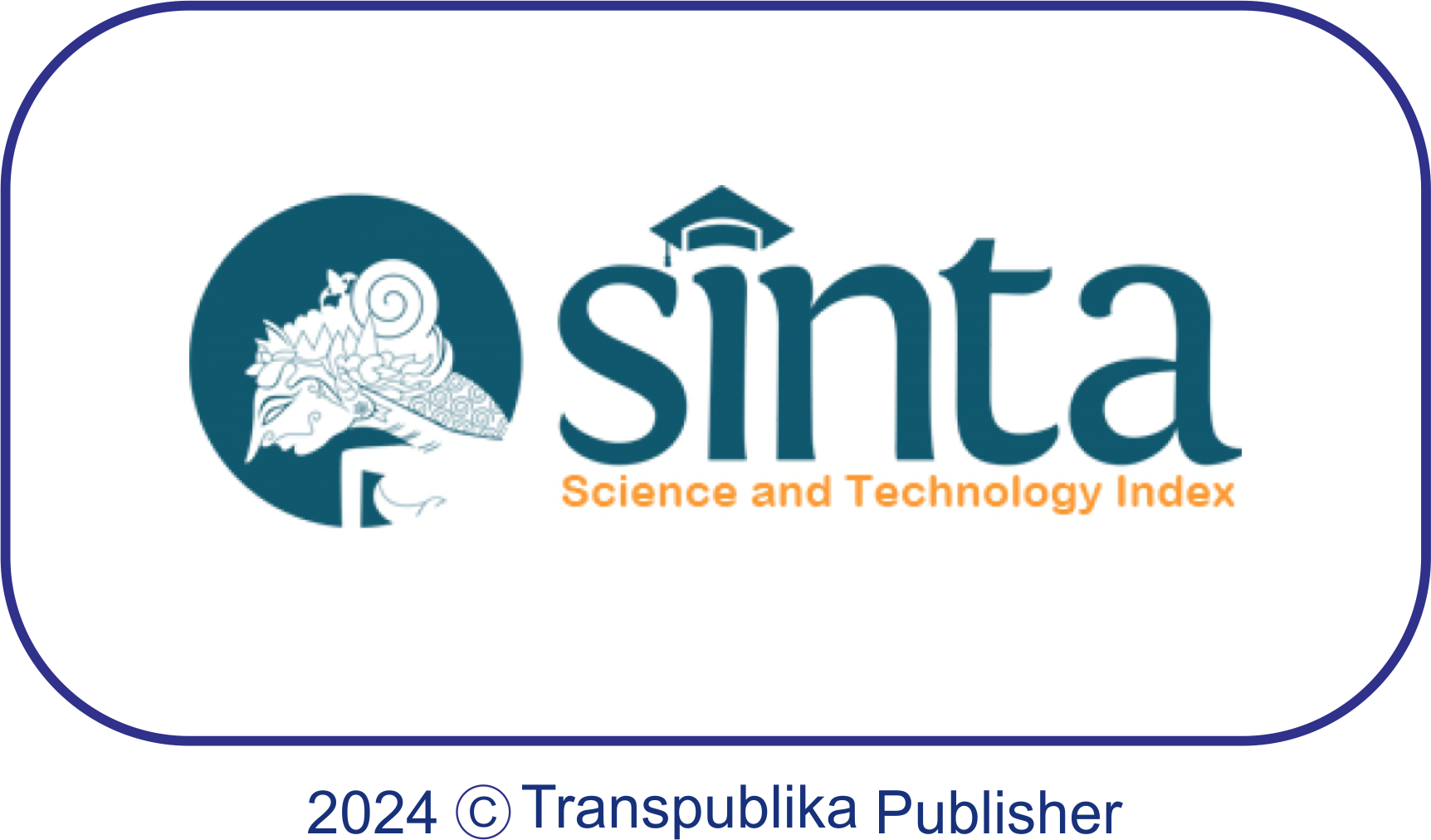Analysis of Risk and Return on Investments in Cryptocurrency Instruments in Indonesia from 2022 to 2024
Abstract
Cryptocurrency has a much higher level of risk and volatility compared to traditional investment instruments such as stocks, thus requiring a deeper understanding of the characteristic differences between the two. This research analyzes the risk profile and return on investment of cryptocurrency compared to stock indices in Indonesia during the 2022–2024 period. This research seeks to examine the characteristic differences between cryptocurrency and traditional stock investments. Using purposive sampling techniques, this research involves five types of cryptocurrency (Bitcoin, Ethereum, Tether, Binance, Ripple) and five stock indices (IHSG, MBX, LQ45, Kompas 100, Bisnis-27) with monthly data totaling 350 observations. The methodology used includes the Shapiro-Wilk normality test for data distribution, followed by the non-parametric Mann-Whitney U test for return and risk variables that are not normally distributed, and the Independent Sample t-test for the Value at Risk (VaR) variable that is normally distributed. The findings shed light that although there is no significant difference in the rate of return between cryptocurrency and stock indices (p = 0.494), cryptocurrency has a much higher level of risk based on standard deviation (p = 0.000) and Historical VaR 95% (p = 0.028). The average VaR of cryptocurrency reaches 23.17%, while stock indices only 6.10%, indicating a potential maximum loss nearly four times greater under worst market conditions. These findings confirm that cryptocurrency is a high-risk asset that demands more careful risk management strategies, and provides important implications for investors and policymakers in designing regulations and investment portfolios that are adaptive to digital market dynamics.
Downloads
References
Aggarwal, V. (2022). Optimum investor portfolio allocation in new age digital assets. International Journal of Innovation Science, 14(3), 648–658. https://doi.org/10.1108/IJIS-10-2020-0237
Agustina, E. (2023). Investment Risk In Cryptocurrency Transactions In Indonesia. MANKEU (Jurnal Manajemen Keuangan), 1(3), 304–328. https://doi.org/10.61167/mnk.v1i3.77
Ahmed, M. Y. (2023). Mutual coupling between stock market and cryptocurrencies. Heliyon, 9(5), e16179. https://doi.org/10.1016/j.heliyon.2023.e16179
Albuquerque, P. H., & Rajhi, W. (2019). Banking stability, natural disasters, and state fragility: Panel VAR evidence from developing countries. Research in International Business and Finance, 50, 430–443. https://doi.org/10.1016/j.ribaf.2019.06.001
Almagsoosi, L. Q. K. (2022). Effect of the Volatility of the Crypto Currency and Its Effect on the Market Returns. Industrial Engineering and Management Systems, 21(2), 238–243. https://doi.org/10.7232/iems.2022.21.2.238
Almeida, D. (2022). Uncertainty and Risk in the Cryptocurrency Market. Journal of Risk and Financial Management, 15(11), 532–549. https://doi.org/10.3390/jrfm15110532
Arsi, S. (2022). Herding Behavior and Liquidity in the Cryptocurrency Market. Asia Pacific Journal of Operational Research, 39(4), 2140021. https://doi.org/10.1142/S0217595921400212
Astawa, I. G. C. A., & Suaryana, I. G. N. A. (2024). Market Reaction To The Enactment Of Finance Minister Regulation Number 120 Of 2023 On Property And Real Estate Stocks. TRANSEKONOMIKA: Akuntansi, Bisnis Dan Keuangan, 4(5), 636–653. https://doi.org/10.55047/transekonomika.v4i5.706
Aste, T. (2019). Cryptocurrency market structure: connecting emotions and economics. Digital Finance, 1(1), 5–21. https://doi.org/10.1007/s42521-019-00008-9
Baur, D. G., Dimpfl, T., & Kuck, K. (2018). Bitcoin, gold and the US dollar–A replication and extension. Finance Research Letters, 25, 103–110. https://doi.org/10.1016/j.frl.2017.10.012
Białkowski, J. (2020). Cryptocurrencies in institutional investors’ portfolios: Evidence from industry stop-loss rules. Economics Letters, 191. https://doi.org/10.1016/j.econlet.2019.108834
Bowala, S. (2022). Optimizing Portfolio Risk of Cryptocurrencies Using Data-Driven Risk Measures. Journal of Risk and Financial Management, 15(10), 427–443. https://doi.org/10.3390/jrfm15100427
Bruhn, P. (2022). Assessing the Risk Characteristics of the Cryptocurrency Market: A GARCH-EVT-Copula Approach. Journal of Risk and Financial Management, 15(8), 346–374. https://doi.org/10.3390/jrfm15080346
Chi, Y., Hao, W., Hu, J., & Ran, Z. (2023). An empirical investigation on risk factors in cryptocurrency futures. Journal of Futures Markets, 43(8), 1161–1180. https://doi.org/10.1002/fut.22425
Chokor, A. (2021). Long and short-term impacts of regulation in the cryptocurrency market. Quarterly Review of Economics and Finance, 81, 157–173. https://doi.org/10.1016/j.qref.2021.05.005
Daluwathumullagamage, D. J., & Sims, A. (2021). Fantastic beasts: blockchain based banking. Journal of Risk and Financial Management, 14(4), 1–43. https://doi.org/10.3390/jrfm14040170
Dewi, G. A. K. R. S., & Vijaya, D. P. (2023). Investasi dan Pasar Modal Indonesia-Rajawali Pers. PT. RajaGrafindo Persada.
Fauzi, A., & Wijoyo, A. (2025). The Impact of Inflation, Exchange Rate, Interest Rate, and Economic Growth on The Indonesia Stock Exchange Composite Index. International Journal of Multidisciplinary Sciences and Arts, 4(3), 1–7. https://doi.org/10.47709/ijmdsa.v4i3.6326
Grobys, K. (2021). Speculation and lottery-like demand in cryptocurrency markets. Journal of International Financial Markets Institutions and Money, 71, 101289. https://doi.org/10.1016/j.intfin.2021.101289
Guesmi, K., Saadi, S., Abid, I., & Ftiti, Z. (2019). Portfolio diversification with virtual currency: Evidence from bitcoin. International Review of Financial Analysis, 63, 431–437. https://doi.org/10.1016/j.irfa.2018.03.004
Gupta, H. (2022). An Empirical Study of Volatility in Cryptocurrency Market. Journal of Risk and Financial Management, 15(11), 513–527. https://doi.org/10.3390/jrfm15110513
Han, S. O. (2023). Is liquidity risk priced in cryptocurrency markets? Applied Economics Letters, 30(17), 2481–2487. https://doi.org/10.1080/13504851.2022.2098235
Hartono, J. (2022). Portofolio dan analisis investasi: Pendekatan modul (edisi 2). Andi Yogyakarta.
Iqbal, F. (2023). Cryptocurrency Trading and Downside Risk. Risks, 11(7). https://doi.org/10.3390/risks11070122
Irfan, M. (2023). Performance Analysis of Gold- and Fiat-Backed Cryptocurrencies: Risk-Based Choice for a Portfolio. Journal of Risk and Financial Management, 16(2), 99-. https://doi.org/10.3390/jrfm16020099
Jorion, P. (2007). Value at Risk: The New Benchmark for Managing Financial Risk (3rd Editio). the McGraw-Hill Companies, Inc., United States of America.
Karim, M. M. (2023). Return-volatility relationships in cryptocurrency markets: Evidence from asymmetric quantiles and non-linear ARDL approach. International Review of Financial Analysis, 90. https://doi.org/10.1016/j.irfa.2023.102894
Kushwah, S. V., Hundal, S., & Goel, P. (2024). Unveiling Interconnectedness and Volatility Transmission: A Novel GARCH Analysis of Leading Global Cryptocurrencies. International Journal of Economics and Financial Issues, 14(3), 132–139. https://doi.org/10.32479/ijeep.14884
Li, L. (2023). Are cryptocurrencies a safe haven for stock investors? A regime-switching approach. Journal of Empirical Finance, 70, 367–385. https://doi.org/10.1016/j.jempfin.2022.12.010
Likitratcharoen, D., Chudasring, P., Pinmanee, C., & Wiwattanalamphong, K. (2023). The efficiency of value-at-risk models during extreme market stress in cryptocurrencies. Sustainability, 15(5), 4395. https://doi.org/10.3390/su15054395
Liu, Y., & Tsyvinski, A. (2021). Risks and returns of cryptocurrency. The Review of Financial Studies, 34(6), 2689–2727. https://doi.org/10.1093/rfs/hhaa113
Lumbantobing, C., & Sadalia, I. (2021). Analisis perbandingan kinerja cryptocurrency bitcoin, saham, dan emas sebagai alternatif investasi. Studi Ilmu Manajemen Dan Organisasi, 2(1), 33–45. https://doi.org/10.35912/simo.v2i1.393
Majok, A. J., Kaluge, D., & Satria, D. (2024). Analyzing the Effects of Interest Rates, Inflation, and Exchange Rates on Stock Market Performance: A Comparative Study Of Indonesia and Japan. Journal of Indonesian Applied Economics, 12(1), 13–26. https://doi.org/10.21776/ub.jiae.2024.012.01.2
Markowitz, H. M. (2008). Portfolio selection: efficient diversification of investments. Yale university press. https://doi.org/10.1111/j.1540-6261.1952.tb01525.x
Marpaung, N. N., & Pangestuti, I. R. D. (2024). Macroeconomic Factors and Jakarta Stock Exchange: A Comparative Analysis Pre-and Until the COVID-19 Pandemic. SAGE Open, 14(2), 21582440241247896. https://doi.org/10.1177/21582440241247894
Nadeem, M. A., Liu, Z., Pitafi, A. H., Younis, A., & Xu, Y. (2021). Investigating the adoption factors of cryptocurrencies—a case of bitcoin: empirical evidence from China. SAGE Open, 11(1), 2158244021998704. https://doi.org/10.1177/2158244021998704
Nuzula, N. F., & Nurlaily, F. (2020). Dasar-dasar manajemen investasi. Universitas Brawijaya Press.
Omane-Adjepong, M. (2021). Herding behaviour in cryptocurrency and emerging financial markets. Cogent Economics and Finance, 9(1), 1933681. https://doi.org/10.1080/23322039.2021.1933681
Panagiotidis, T., Papapanagiotou, G., & Stengos, T. (2022). On the volatility of cryptocurrencies. Research in International Business and Finance, 62, 101724. https://doi.org/10.1016/j.ribaf.2022.101724
Papadamou, S. (2021). Herding behaviour and price convergence clubs in cryptocurrencies during bull and bear markets. Journal of Behavioral and Experimental Finance, 30. https://doi.org/10.1016/j.jbef.2021.100469
Pessa, A. A. B., Perc, M., & Ribeiro, H. V. (2023). Age and market capitalization drive large price variations of cryptocurrencies. Scientific Reports, 13(1), 3351. https://doi.org/10.1038/s41598-023-30431-3
Petukhina, A. (2021). Investing with cryptocurrencies–evaluating their potential for portfolio allocation strategies. Quantitative Finance, 21(11), 1825–1853. https://doi.org/10.1080/14697688.2021.1880023
Platanakis, E., & Urquhart, A. (2020). Should investors include bitcoin in their portfolios? A portfolio theory approach. The British Accounting Review, 52(4), 100837. https://doi.org/10.1016/j.bar.2019.100837
Pradja, H., & Taufiq, M. (2024). Pengaruh Pengalaman Investasi, Tingkat Risiko, dan Influencer Sosial Media Terhadap Keputusan Investasi pada Mahasiswa/I UNPAB. J-CEKI: Jurnal Cendekia Ilmiah, 4(1), 1354–1362. https://doi.org/10.56799/jceki.v4i1.6200
Raihan, A. M., & Saksana, J. C. (2023). Analysis of stock price index volatility in Indonesia using macroeconomic variables and global economic uncertainty index. Assets: Jurnal Ekonomi, Manajemen Dan Akuntansi, 13(1), 83–100. https://doi.org/10.24252/assets.v13i1.37616
Rejeb, A., Rejeb, K., & Keogh, J. G. (2021). Cryptocurrencies in modern finance: a literature review. Etikonomi, 20(1), 93–118. https://doi.org/10.15408/etk.v20i1.16911
Sari, M. N. (2020). Pengaruh Return On Asset, Financial Leverage, Dan Trading Volume Terhadap Initial Return. Jurnal Akuntansi Bisnis Dan Publik, 11(1), 18–27. https://journal.pancabudi.ac.id/index.php/akuntansibisnisdanpublik/article/view/952/894
Sari, M. N. (2023). Hedging cryptocurrency sebagai alternatif dalam investasi. Jurnal Bina Akuntansi, 10(1), 348–363. https://doi.org/10.52859/jba.v10i1.360
Sihombing, S., Nasution, M. R., & Sadalia, I. (2021). Analisis Fundamental Cryptocurrency terhadap Fluktuasi Harga: Studi Kasus Tahun 2019-2020. Jurnal Akuntansi, Keuangan Dan Manajemen, 2(3), 213–224. https://doi.org/10.35912/jakman.v2i3.373
Sovbetov, Y. (2018). Factors influencing cryptocurrency prices: Evidence from bitcoin, ethereum, dash, litcoin, and monero. Journal of Economics and Financial Analysis, 2(2), 1–27. https://doi.org/10.1991/jefa.v2i2.a16
Thies, F., Wallbach, S., Wessel, M., Besler, M., & Benlian, A. (2022). Initial coin offerings and the cryptocurrency hype-the moderating role of exogenous and endogenous signals. Electronic Markets, 32(3), 1691–1705. https://doi.org/10.1007/s12525-021-00460-9
Tjondro, E., Hatane, S. E., Widuri, R., & Tarigan, J. (2023). Rational versus irrational behavior of Indonesian cryptocurrency owners in making investment decision. Risks, 11(1), 17. https://doi.org/10.3390/risks11010017
Tsuruta, M. (2020). Decomposing the term structures of local currency sovereign bond yields and sovereign credit default swap spreads. The North American Journal of Economics and Finance, 51, 101072. https://doi.org/10.1016/j.najef.2019.101072
Utomo, S. H., Wulandari, D., Narmaditya, B. S., Handayati, P., & Ishak, S. (2019). Macroeconomic factors and LQ45 stock price index: Evidence from Indonesia. Investment Management and Financial Innovations, 16(3), 251–259. https://doi.org/10.21511/imfi.16(3).2019.23
Wijaya, C. A., & Ulpah, M. (2022). The Analysis of the Roles of Bitcoin, Ethereum, and Gold as Hedge and Safe-Haven Assets on the Indonesian Stock Market before and during the COVID-19 Pandemic. Indonesian Capital Market Review, 14(1), 51–62. https://doi.org/10.21002/icmr.v14i1.1140
Copyright (c) 2025 Rizki Hidayat, Renny Maisyarah

This work is licensed under a Creative Commons Attribution 4.0 International License.








.png)







.png)


.png)

.png)















